Can I Just Scatter Poppy Seeds? Tips for Successful Planting
Thinking about adding a splash of color to your garden? Scattering poppy seeds could be the perfect solution. These vibrant flowers not only brighten up any space but also serve as a food source for wildlife, making them a great choice for eco-conscious gardeners. You can simply scatter poppy seeds into prepared soil to enjoy beautiful blooms with minimal effort.
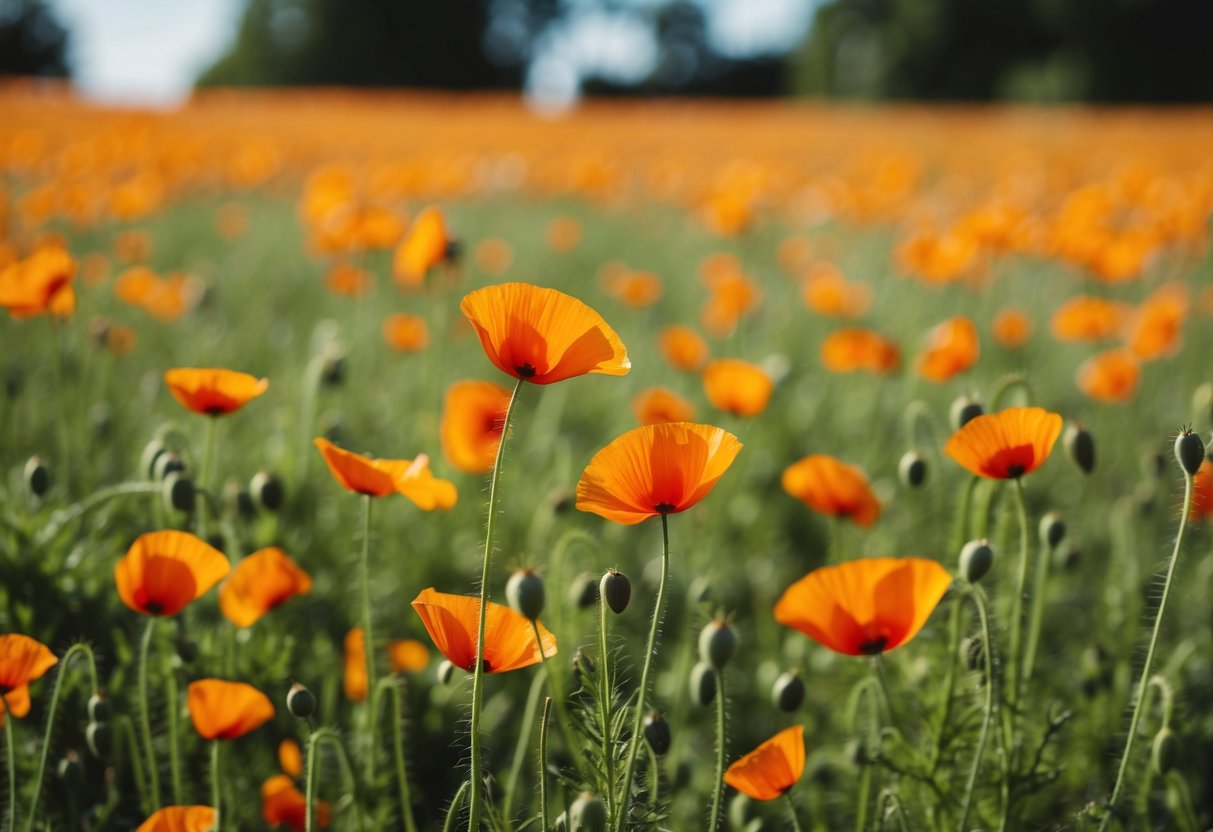
Poppy seeds are tiny, making them easy to spread across your garden. This scattering method mimics the way poppies naturally grow in the wild, where wind and weather help them find a suitable spot. As long as you have a weed-free bed, these seeds can take root and thrive, promising a garden full of stunning blooms.
To get the best results, consider scattering your seeds in the late fall or early spring. This gives them the chance to settle into the soil and prepare for growth. With a little patience and care, your garden could soon be filled with the delicate beauty of poppies.
Understanding Poppy Varieties
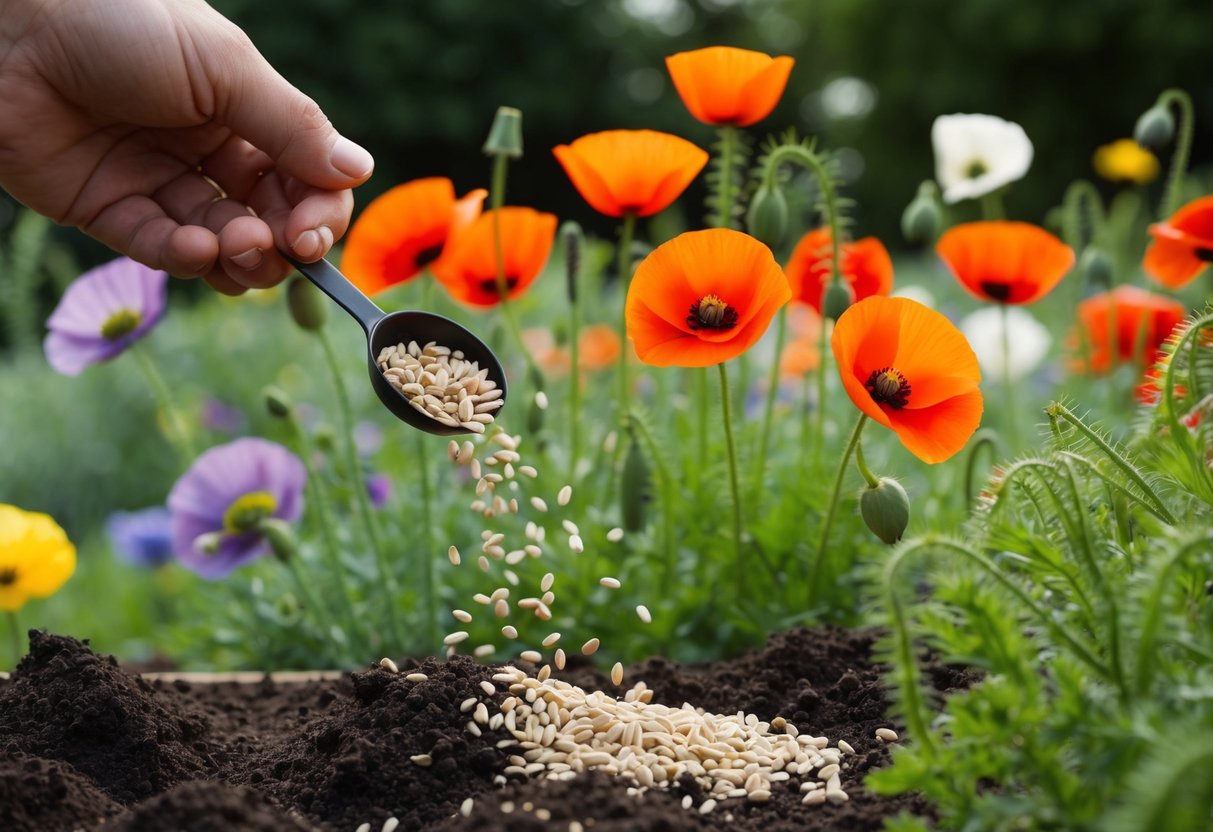
Poppies come in many varieties, each with unique features. Whether annual or perennial, understanding their differences can help you choose the right ones for your garden.
Identifying Common Poppy Species
There are several notable poppy species you might consider growing. The Papaver rhoeas, often called the corn or field poppy, is famous for its bright red petals. It adds a vibrant splash of color to gardens and fields. The Eschscholzia californica, known as the California poppy, has eye-catching orange or yellow blooms. This poppy thrives in warmer climates and is often used in wildflower gardens.
Another important type is the Papaver somniferum, commonly named the opium poppy. This species is known for its pale flowers and seed pods, which can be used for culinary purposes. In contrast, the Oriental poppy produces large, showy flowers in a variety of colors, making it a favorite for ornamental gardens. Each type of poppy offers something unique, so consider your climate and garden style when choosing.
Annual vs. Perennial Poppies
Knowing whether poppies are annual or perennial can affect how you plan your garden. Annual poppies, such as the corn poppy and California poppy, complete their life cycle in one growing season. They germinate, bloom, and set seed before dying. For continuous blooms, re-sowing each year is necessary.
Perennial poppies, like the Oriental poppy, return year after year. These poppies require a bit more initial care but can reward you with blooms for many seasons once established. Their roots survive through the winter and regrow each spring. Understanding these differences can help you decide the best planting strategy for your garden needs.
Preparing for Planting

To grow poppy seeds successfully, start by ensuring good soil conditions and consider stratification techniques if you’re in a cooler climate. These steps will help you prepare for a thriving poppy garden.
Soil Conditions and Requirements
When planting poppy seeds, soil preparation is key. Start by choosing a spot that gets full sun, as poppies love sunlight. The soil should be well-draining to prevent water from pooling around the seeds, which can cause them to rot. Adding compost to your garden bed enriches it, making it more fertile and ready for planting.
Even if the soil is poor, amending it with organic matter can improve its quality. Poppies can tolerate less-than-ideal soil, but they thrive best in a fertile environment. Before sowing, loosen the dirt to make it easy for seedlings to sprout. Remember that poppy seeds are small, so they benefit from being lightly scattered across the top: not too deep, just enough to be covered by a thin layer of soil.
Stratification: A Special Note for Cooler Climates
In cooler climates, stratification is an important step. This process involves simulating winter conditions to help seeds germinate more easily. To do this, you can place the seeds in a plastic bag with a damp paper towel and refrigerate them for four to six weeks.
This mimics the natural wintering process that poppy seeds would experience in the wild. By doing so, you encourage stronger germination when you eventually plant them outside. It might sound complicated, but this simple method can make a big difference in getting your poppies to sprout and grow vigorously. So, if you live in a cooler region, don’t skip this tip—it could greatly improve your chances of seeing beautiful blooms.
Sowing Poppy Seeds
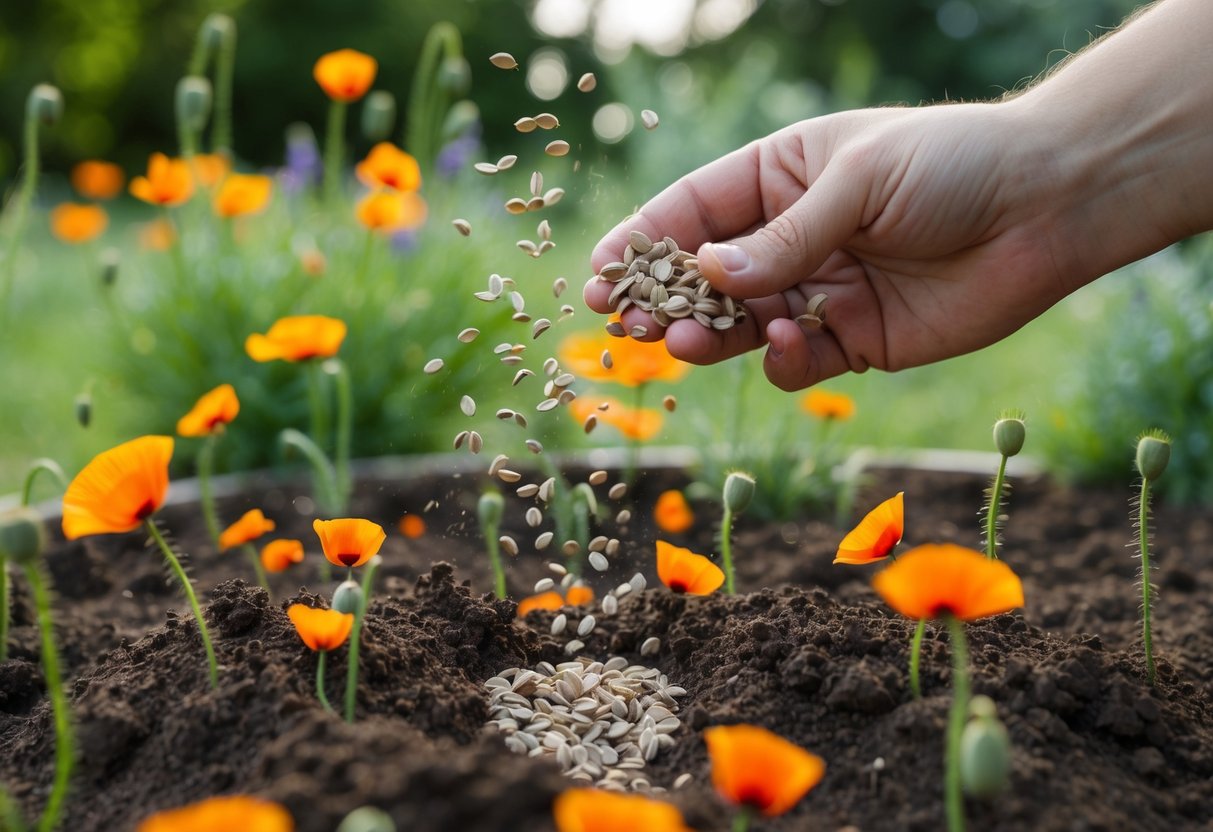
Scattering poppy seeds is a simple way to start growing these beautiful flowers. It’s important to know the best techniques and timing to achieve successful germination and growth.
Effective Scattering Techniques
To scatter poppy seeds, you’ll want to choose a sunny spot with well-drained soil. Begin by raking the soil to create a fine, even seedbed. Mixing the seeds with sand can help space them out better and make them easier to see against the soil, preventing accidental oversowing.
Once prepared, evenly scatter your poppy seeds across the soil. Lightly press the seeds into the soil, but don’t cover them deeply because they need light to germinate. If possible, water gently to avoid displacing the seeds.
Optimal Timing for Seed Germination
Poppy seeds require a period of cold to sprout effectively. The best time to scatter poppy seeds is in early spring or late fall. In spring, sow them while there’s still a chance of frost. This cold exposure aids in seed germination.
In regions with mild winters, you can sow them in late fall. They will lie dormant over the winter and begin to grow as temperatures warm. If you start too late in spring, your poppies might not have enough time to mature before it gets too hot, which can hinder their growth.
Post Planting Care
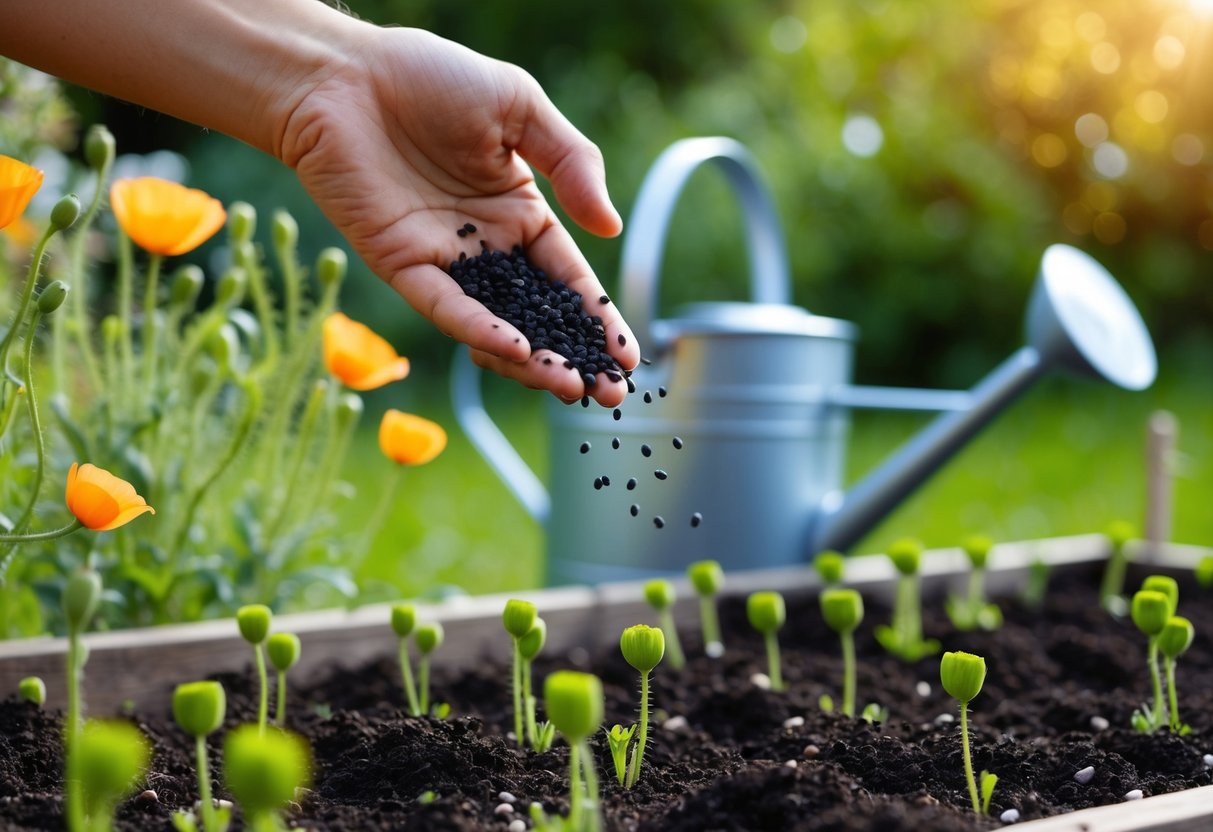
After scattering poppy seeds, it’s important to care for them properly to ensure they thrive. This involves managing soil moisture, protecting them from pests, and supporting their growth.
Watering and Soil Moisture Management
Keeping the soil evenly moist is key for poppy growth. You should water the seeds gently to avoid washing them away. It’s crucial to maintain consistent soil moisture, especially during germination. Adding a layer of mulch can help retain soil moisture and reduce evaporation. Poppies don’t like soggy conditions, so ensure the soil drains well. Check the soil regularly and water lightly when the top layer feels dry.
Dealing With Common Pests and Diseases
Poppy plants can face challenges from pests and diseases. Powdery mildew is a common issue due to lack of air circulation. To prevent this, space the plants properly to allow airflow. You might encounter pests like aphids, which can be managed with insecticidal soap. Regular inspection is key. Remove any infected leaves to stop the spread of diseases and keep your plants healthy.
Supporting Poppy Growth and Vigor
To support poppy growth, make sure they are in a place with full sunlight. Besides watering, use these gardening tips for optimal growth: Mulching can provide nutrients and regulate temperature. Occasionally, you may need to gently loosen the soil for air circulation. This encourages healthy roots. Prune any damaged foliage to direct energy to stronger parts of the plant. These steps can enhance your poppies’ beauty and vigor.
Harvesting and Propagation
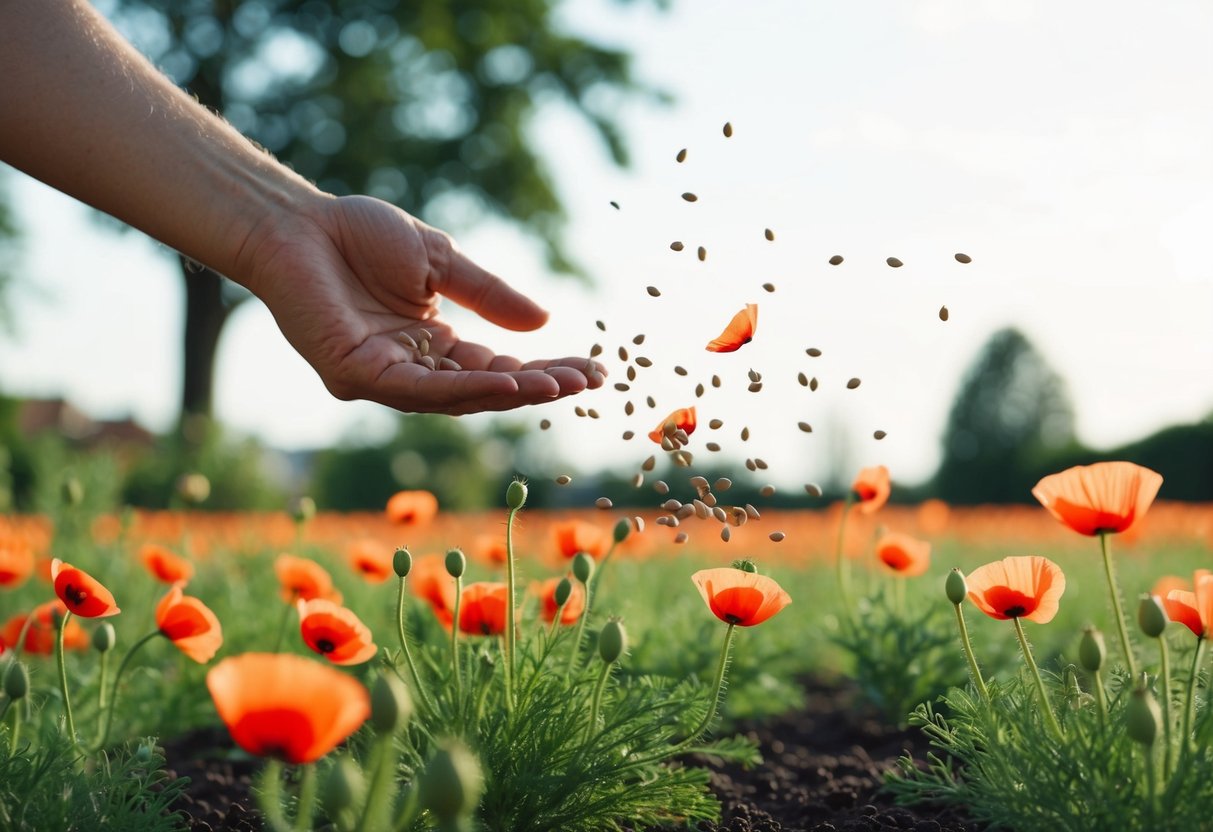
Poppies are fascinating plants with unique ways of spreading their seeds. You can collect seeds for planting, and poppies can also self-seed, making them an intriguing addition to your garden.
Collecting and Storing Poppy Seeds
To collect poppy seeds, wait until the pods make a dry, rattling sound. This indicates the seeds are ready for harvest. Check that 70-90% of the poppy heads have turned brown and are starting to crack. Hold a container under the pod and gently shake it to release the seeds.
Place the seeds on a paper towel to dry for a few days. Once they’re dry, store them in an airtight container. Keep them somewhere cool and dark until you are ready to plant them. These seeds can also be used in cooking, as edible seeds often found in baking.
Understanding Self-Seeding Habits
Poppies are self-seeding plants. This means they naturally drop seeds that grow into new plants the next year. Both annual and perennial poppies do this. Once they drop, you’ll notice small plants sprouting up in places you might not expect.
Some species, like the California poppy, are known to spread widely. Self-sown seeds can lead to beautiful clusters of blooms year after year. Allowing your poppies to self-seed can create a natural, wild look in your garden. Regularly observing and understanding their self-seeding habits can help manage plant spread and maintain your garden’s appearance.







